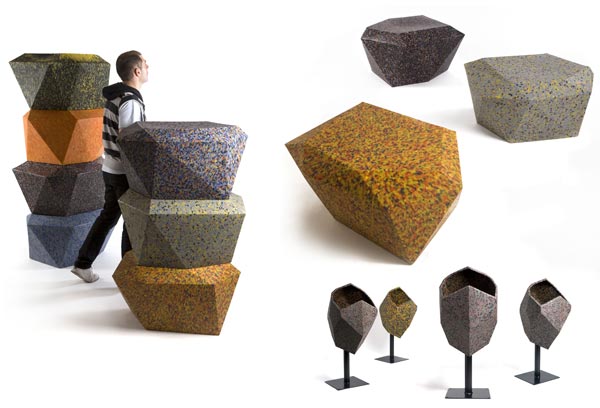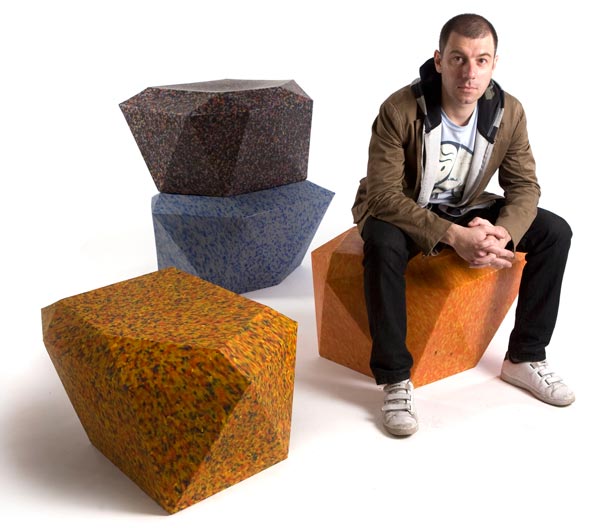
We’ve had our eye on Chilean designer Rodrigo Alonso for a minute now. The last time his work caught our attention was with his super playful line of jewelry dubed Jocale. And now we’re obsessing over his recycled plastic furniture. He used 100% waste obtained from random electronic devices, toys, drink trays, stadium seats and more to make this line—all shit used in very few end products due to the complexity of separating the various materials. His solution was simple, which makes it even more rad. He was able to do this by a technique called Rotomolding, a simple way of melting the plastic down into super durable material. And the end product is pretty damn good looking too. Why more people aren’t doing exactly this for stuff like urban furniture that you see in a park, or in a shopping mall, or even your patio or home furniture. Just build a big ass Rotomolding machine and make massive use of plastic waste. Reuse and sustainability…it all makes sense to me.
Make the jump to read our interview with Rodrigo Alonso….
“I’m my worst enemy. I have learned a lot along the way. I don’t consider myself as an “eco designer”, but I try to make every step, the least environment invasive as possible.”
– Rodrigo Alonso

How’d you get your start doing what you do?
I started since I have memory, when I created my own toys. I designed, made the plans (basics and poorly done), builded and also destroyed them, in order to continue doing more and more toys. This way I realized that conceptualize, create and produce, filled my soul. Until today I feel like I’m still playing every time I design.
Was PR something you did to help pay the bills? Starving artist kinda thing…
No, I just did a good work. At the beginning I started working for design and advertising agencies and then I went on my own. Everything I have done, I done it with all my energies, joy and in the most professional way. The only way to go forward is: working, working, working.
How, if at all, has Chile played a roll in your creative output?
Chile has played one of the most important roles. Although my father is from Spain and my grandfather from Germany, I’m thankful to be born in this part of the world. Chile has allowed me find many things that are not elsewhere and make creativity takes other paths and seek other kind of solutions, that is to say, working in many cases with lack of resources, technologies and policies associated to creations or design, but with a lot of joy, energy, magic and resilience to learn from each of our mistakes and understand that at the end, we have our own language, that is to say, how to do a lot with little.
Do you come from a creative family?
I don’t think so, although my mother always encourage me to draw and be creative.
I’d like to know about where you’re coming from a personal level with the pieces you make, your designs.
I come from a world far more intuitive. I’m a graphic designer and I fix or develop, every new product from the perspective who speaks with “accent”, the industrial design language, since is not my “native tongue”, I learned much later. For this reason, every new product, object, decoration or creation comes from an area with less rigid rules.
Does sustainability have influence in your overall design approach?
More every time. Today I face each new creation with a much more critical opinion from my own work, especially about sustainability practices or the least possible impact. I’m my worst enemy. I have learned a lot along the way. I don’t consider myself as an “eco designer”, but I try (from quite a while) to make every step, the least environment invasive as possible. For this reason I stopped producing several objects (even if is a good business) that I consider unnecessary in some kind of material or which represents any risk at the moment of discard, for example, virgin plastics.
How do you go about getting your raw material for this new series of work?
In the World, there are several ways to reuse materials. The plastic, generally allows several uses, but occasionally and in the most cases, the new uses are more poor and have shorter life that the first ones. That is to say, the useless plastic, generally are reused in soft drink caps, food packaging or other less powerful visual object, but sooner or later end up irreparably in the garbage. These materials are from this plants which recollects post consume plastic, which are transformed in raw material for new products like soft drink caps, clothe hangers, etc, but have a very short life. The materials are bought in large quantities (tons) and the color or graphics in them depends on the type of product that has been recovered at that time, for example, I can find in some moment only with orange stadium seats and in other moment with multicolor soft drink caps, or a mixture of everything. This, define the final color, even tough we are working on the best way to achieve a color range in order to group them better and provide more manageable types of products in stock. This plant is asked to not make more process (with this, avoiding to expend more energy than necessary) and to deliver it only trashed and unpelletized. This gives the multicolor tone in pieces of a size of a fingernail. My intention with this research is to make from this discarded plastic, a material of much greater duration or a longer life object, to bring it raw into pieces that works for many years and, when are treated by shopping malls, city halls, parks, etc., there is more control over the furniture damaged by users, vandalism, crashes, etc. and thanks to this, it can be returned, trashed and rotomoulded again in order to produce a new object.
What makes good design, good?
His honesty and unpretentious simplicity. Is like a real smile. The one that you recognize immediately.
I see that that you’re now part of the International Council of Societies of Industrial Design. What does that mean for you, as a designer/artist?
A huge support for my work and for my office on the legal, PR and professional area. QVID supports the quality work, with its extensive contact network and assistance when necessary in case of copyrights, misfeasance or bigger problems.
What’s the most interesting example of design work you’ve seen over the last year? Be it industrial, fashion, product, packaging, etc.
The work of Alejandro Aravena.
What does the word experimental mean to you?
It means getting “dirty”
Proudest professional achievement?
Having reassembled my office with my partners and friends, 3 months after my former partners rip me off.
What’s the last piece of technology that has affected your creative output?
For good: Time capsule; for bad: nothing till now.












Appreciate your taking this opportunity to talk about this, Personally i think strongly about it and I make use of garden greenhouse structures this subject. If at all, while you gain data, please update this web site with new information. I’ve found it extremely useful.